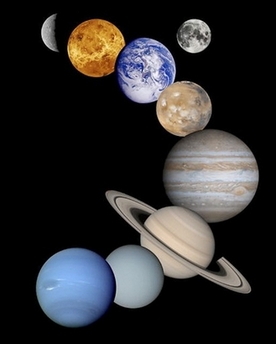PRAGUE - The solar system may soon be home to a dozen planets, with three new
additions to the club and more to come, if astronomers meeting in the Czech
capital approve a new planetary definition, the conference organizer has said.

This 2001 NASA montage
of planetary images was taken by spacecraft managed by the Jet Propulsion
Laboratory in Pasadena, California. From top to bottom: images of Mercury,
Venus, Earth (and Moon), Mars, Jupiter, Saturn, Uranus and Neptune. The
solar system may soon be home to a dozen planets, with three new additions
to the club and more to come, if astronomers meeting in the Czech capital
approve a new planetary definition, the conference organizer has said.
[AFP] |
The proposal before the 26th general assembly of the International
Astronomical Union distinguishes between planets and smaller celestial bodies
such as comets and asteroids.
That results in a 12-planet solar system with eight classical planets and
three bodies including Pluto in a new and growing category called "plutons" -
Pluto-like objects - plus a former asteroid, Ceres, the IAU said.
Powerful new telescopes that have discovered large objects in the outer
regions of the solar system present a challenge to the historically based
definition of a "planet", which comes from the Greek word meaning "wanderer".
"Recent new discoveries have been made of objects in the outer regions of our
solar system that have sizes comparable to and larger than Pluto," said IAU
President Ron Ekers in a statement.
"These discoveries have rightfully called into question whether or not they
should be considered as new 'planets'."
The planetary debate blasted off in July 2005 when a US team of astronomers
announced that Pluto is much smaller than an enigmatic object, 2003 UB313, which
its discoverers claim is the solar system's 10th planet.
UB313, found some 15 billion kilometres (nine billion miles) from Earth,
ignited a huge row as Pluto's defenders said UB313 was not a planet, just a
rock, or KBO -- Kuiper Belt Object -- which is the term for the estimated
100,000 pieces of icy, primeval debris encircling the sun on the outskirts of
the solar system.
Since its founding in 1919, the IAU has been the arbiter in astronomical
debates and after two years of work a committee has come up with a new planet
definition to present to some 2,500 astronomers gathered in Prague through
August 25.
According to the draft definition, a "planet" must be in orbit around a star,
while not being itself a star, and it must be massive enough for its own gravity
to pull it into a nearly spherical shape.
"Our goal was to find a scientific basis for a new definition of planet and
we chose gravity as the determining factor. Nature decides whether or not an
object is a planet," said Richard Binzel, a member of the defining committee.
That puts about dozen "candidate planets" on the IAU watchlist, which means
even more planets could be named in the future.
If the current proposal is passed by the IAU assembly, the solar system would
consist of the planets Mercury, Venus, Earth, Mars, Ceres, Jupiter, Saturn,
Uranus, Neptune, Pluto, Charon and 2003 UB313 (a "real" name to be chosen
later).
The new "plutons" are distinguished from classical planets in that they
reside in orbits around the sun that take longer than 200 years to complete --
meaning they are in orbit beyond Neptune.
The draft "planet definition" resolution will be discussed and refined during
the Prague meeting and put up for a vote on August 24.